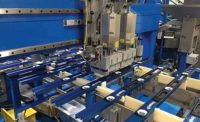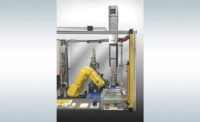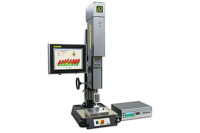Established in 1917, LEONI AG is a global supplier of wires, optical fibers, cables, cable systems and related services for the automotive industry. Based in Nuremberg, Germany, the company operates 24 manufacturing facilities worldwide, and its product offerings range from single-core automotive cables to complete wiring systems.
Traditional ultrasonic welding has been performed at select LEONI plants for a few years. However, torsional ultrasonic welding (TUW) is only done at one plant, located in Arad, Romania. There LEONI has been operating a fully automated cell for welding solid aluminum bus bars since early 2014.
British automaker Jaguar uses the bus bars, instead of copper cables, to significantly reduce the weight and cost of its F-TYPE sports car. Each bus bar conducts electricity from the battery in the vehicle boot to electric equipment in the engine compartment.
“Because aluminum has a significantly lower relative density than copper, the bar only weighs about 40 to 60 percent of conventional copper cable,” explains Kai Baumann, production process engineer for LEONI. “For the battery connection alone, this can amount to a reduction in weight of up to 3 kilograms.”
The cell features a Soniqtwist TUW system developed by Telsonic AG. Unlike traditional ultrasonic welding, which applies linear vibrations at the joint interface, TUW applies linear vibrations in combination with a twisting motion at the same frequency. This twisting action produces a strong weld at the molecular level.
During operation, a six-axis robot retrieves a bus bar from a holding area and positions its front end on an anvil beneath the sonotrode. The robot then grabs a 30-millimeter-long threaded interface stud, presses it into a copper-nickel sleeve and places the sleeve next to the bus bar. Welding of the sleeve and bus bar takes only 0.9 second.
Baumann says the sleeve significantly strengthens the copper-to-aluminum weld and minimizes the risk of corrosion between the two metals. To ensure repeatability and quality, the anvil is water cooled.
After welding, the bus bar is three dimensionally shaped by the robot. A finished bus bar leaves the cell every 30 seconds, enabling the plant to produce up to 700,000 units annually. Bus bars are shipped to Jaguar in special crates.
Assembly line workers use a fixing system to position each bus bar within the F-TYPE sports car. Special clips along the bus bar are then attached to the car body.
“[Assemblers] find the rigid bus bars much easier to install than flexible cables,” claims Baumann. “Anybody who up to now had to install the heavier copper cables will breathe a sigh of relief.”
The Soniqtwist system features one or more converters, a torsional head, a high-power torsional sonotrode and an optional booster. When equipped with four converters, the system’s maximum output is 10 kilowatts, enabling it to weld very large parts.
For metal welding, the sonotrode is usually made of high-quality, hardened tool steel that can be specially coated. For plastic welding, the sonotrode may be made of tool steel, aluminum or titanium.
For more information on torsional ultrasonic welding, call 617-244-0400 or visit www.telsonic.com.





